Letters from Lodi
An insightful and objective look at viticulture and winemaking from the Lodi
Appellation and the growers and vintners behind these crafts. Told from the
perspective of multi-award winning wine journalist, Randy Caparoso.
Why wine glass shapes matter
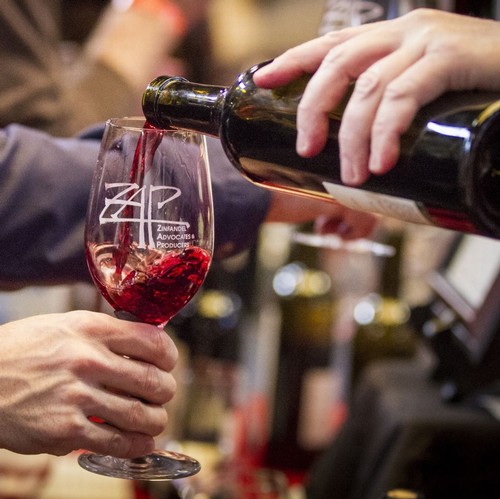
Zinfandel served in its ideally shaped wine glass at the yearly Grand Tasting held by ZAP (Zinfandel Advocates & Producers) in San Francisco.
If you're a wine lover, you might have heard that the choice of shapes of wine glasses makes a difference. If you're doubting Thomas, all I can say is this: It is true. Certain types of wines taste better in certain types of glasses.
In some cases, the differences are huge—wines tasted in different glasses practically taste like different wines. I've sat through enough controlled tastings involving the same wines served in multiple glasses to have walked away thoroughly convinced of that.
In other words, you can improve the taste of almost any wine simply by changing up your glasses. Apart from wine glass shapes, the only factor that has as big an impact on the perception of wine is serving temperature, which is a subject for another post. The tricky part, though, is if you have a habit of enjoying different types of wines. Say, you love Pinot Noir, Zinfandel, or Cabernet Sauvignon—there is a different, and ideal, wine glass for each of these varietals. Does that mean that you need a different wine glass for each of these wines? Yes and no. Yes, if you wish to be a total freakazoid about getting the most out of your wines; and obviously no, if you are less inclined.
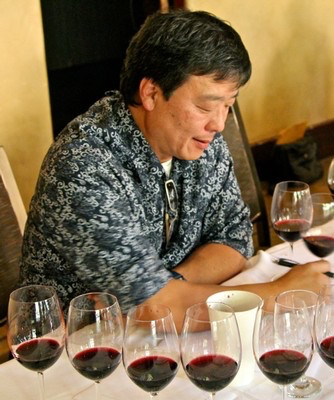
David Akiyoshi, winemaker for Lodi's LangeTwins Family Winery & Vineyards, during a blind tasting of Lodi Zinfandels, utilizing classic tulip-shaped wine glasses.
In any case, for white wine lovers there is also such a thing as an ideal glass for Chardonnay—particularly American-style Chardonnays, which are pungent in fruit qualities and often barrel fermented and aged, meaning they have a significant amount of oak qualities in the aroma and flavor which help boost the varietal fruit character of the wine.
Many Chardonnay lovers, however, are aware of the fact that the grape originated somewhere in the proximity of France's Burgundy region, and Burgundy produces a slightly different style of Chardonnay because its climate and soils are different from most of California. In Burgundy, Chardonnay-based whites tend to be more citrusy (particularly, lemon-like) than California Chardonnays. They don't necessarily have less oak intensity—the French are just as big believers in the value of oak as Californians (most of whom, after all, are merely imitating the French)—but Burgundian styles also have more earth or mineral-related aromas and flavors, besides the fact that they tend to be a tad lighter (closer to 13% alcohol, rather than the 14%-15% alcohol levels of typical California Chardonnays) and less overtly fruity.
Therefore, lovers of white Burgundy usually look for slightly different qualities in their Chardonnays. Also, therefore, there is a larger, wider-shaped wine glass considered to be ideal for the Burgundian style; a glass that emphasizes crisper textures and mineral nuances, as opposed to the sheer richness of fruit and the opulent texturing associated with California styles.
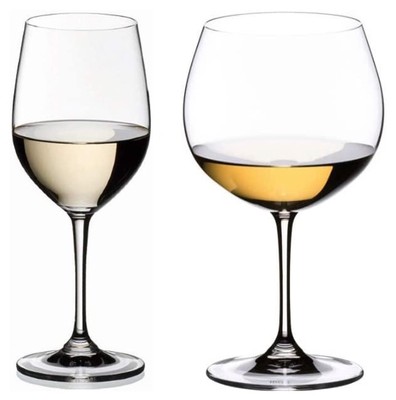
Two different glasses designed for Chardonnay-based whites: on left, the tulip-shaped Riedel Viognier/Chardonnay glass (12.3-ounce capacity) meant to highlight lush fruitiness; on right, the larger, wider Riedel Oaked Chardonnay/Montrachet glass (21.1-ounce capacity) meant to highlight crispness and minerality.
Does that mean you should have a different glass for every style of Chardonnay grown in the world? No. Even wine geeks and sommeliers don't usually go that far. All the same, the shape of wine glasses matters, even if this is more of an intellectual matter, rather than practicality. Fine wine, after all, is something that appeals as much to the intellect as it does to the senses.
In the following comparisons of wine glass shapes, I am citing just a few of the basic profiles designed by Riedel; particularly those in this company's VINUM series, which are machine-made wine glasses that retain the fine feel of lead-free crystal. There are many other brands producing excellent wine glasses that are most certainly comparable to Riedels in terms of quality, size, and shape and are not always as expensive. For the sake of discussion, however, we will use a few of Riedel's basic models to address the pros and cons of the various wine glass shapes, and you can take it from there.
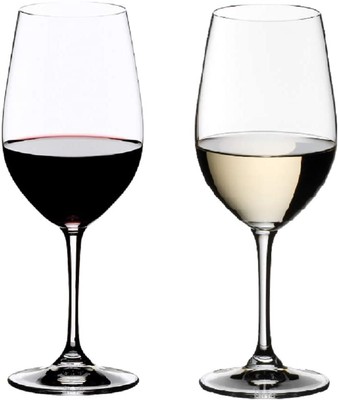
The Riedel Zinfandel/Riesling/Chianti glass; is 14-ounce capacity, and 8.25 inches tall.
The best (generally) wine glass for Zinfandel
We live in Lodi, though, so Zinfandel is a big part of our wine diets. Less than 10 years ago, I attended a tasting seminar put on by Georg Joseph Riedel, the 10th-generation leader of this Austria-based glass manufacturing company. In this particular seminar. Mr. Riedel wished to demonstrate the efficacy of his design for Zinfandel, which happens to be the exact same wine glass he recommends for Riesling and Chianti (the latter, an Italian red wine made from Sangiovese grapes).
Riedel made his case by pouring the exact same Zinfandel in seven different wine glasses, asking a group of sommeliers (whom I had invited) and Zinfandel winemakers to vote on their preferences. Mr. Riedel's recommended Zinfandel glass turned out to be one of the top two choices of the group. It wasn't my favorite, but it certainly was one of my favorites, for this reason: The glass's narrow tulip shape, which has just a 14-ounce capacity, has a way of funneling the fruit aromas of Zinfandel to the nose, which significantly accentuates the sweet or "jammy" berry qualities of the varietal.
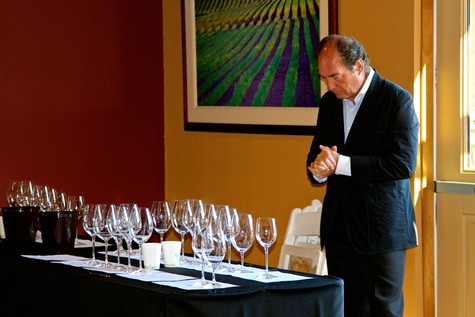
George Riedel, setting Zinfandel tasting consisting of 7 different Riedel wine glasses.
This small, narrow tulip shape is also excellent for Riesling and Chianti for the exact same reason: These are wines that are judged by optimal fruit intensity—the more intense and focused the perception of fruit, the higher the perception of "quality."
In that particular seminar, however, my own preferred glass was one that was similar to Riedel's Cabernet/Merlot glass, which is another narrow tulip shape but with a larger capacity—21 ounces, as opposed to the 14 ounces of the Zinfandel glass. I found that a larger glass furnishes more surface area to swirl a wine and collect aromatic vapors beneath the curved rim. The advantage of the increased surface is that it allows a Zinfandel to express more nuances, going beyond a simple, berry-like fruitiness. Personally, I do not judge a Zinfandel simply on the basis of its fruit intensity. I also look for some degree of spice (such as peppercorn and clove), earthy aromas (such as loam or mushrooms), as well as increased discernment of crafty use of oak barrel aging (suggesting vanilla or toast in the nose)—qualities that can get buried under a rush of fruit-dominant aromas when pushed out of a smaller, 14-ounce Zinfandel glass.
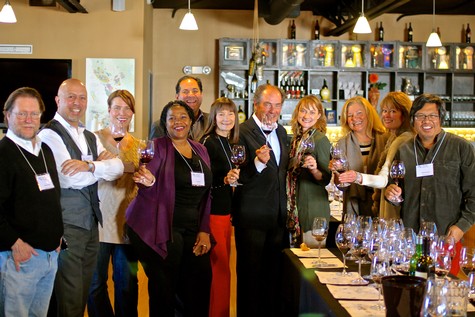
George Riedel (center) with sommeliers who participated in Mr. Riedel's demonstration of his recommended "Zinfandel" glasses.
As it were, when I normally evaluate Zinfandels on a professional basis, I typically utilize Riedel's 14-ounce glass anyway. Why? Because it gives me an "industry standard" by which to make sensory assessments. But if I'm having an interesting Zinfandel with dinner, I'll usually pull out a larger-sized tulip, which is more likely to give a rounder taste and expanded "nose."
Precisely because its narrow shape helps to funnel fresh fruit fragrances to the nose, Riedel's Zinfandel/Riesling/Chianti glass is also ideal for almost all dry rosés and white wines, especially Sauvignon Blanc, Pinot Grigio (also sold as Pinot Gris), and that Lodi favorite, Albariño. Although Riedel recommends a considerably larger glass for Tempranillo-based reds (and Spanish counterparts made from the same grape, grown in Rioja or Ribera del Duero), I would suggest that this glass is also ideal for Tempranillo—particularly Lodi-grown Tempranillos, whose strong suits are bright red fruit qualities (cherry, strawberry, pomegranate, licorice, etc.) with just smidgens of dusty earthiness.
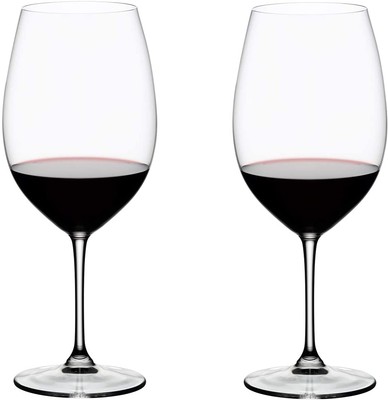
The Riedel Cabernet/Merlot glass; 21-ounce capacity, 9.25 inches tall.
The ideal Cabernet/Merlot glass
Riedel actually offers a variety of glass shapes for "Bordeaux" varietals (besides Cabernet Sauvignon and Merlot, also Cabernet Franc, Malbec, Petit Verdot, plus blends of any of the aforementioned grapes).
The big difference between Riedel's classic Cabernet/Merlot glass and its recommended Zinfandel glass is size: a 21-ounce capacity as opposed to the Zinfandel glass's 14 ounces, plus a 9.25-inch height as opposed to the Zinfandel's 8.25 inches. The extra surface area in the glass allows for more aromatic nuances to emerge in the aromas once a wine is swirled, which is especially important for red wines made from Cabernet Sauvignon and Merlot because they tend to have more color and tannin content, adding to a greater sense of body or weight to these wines, which can diminish the perception of aromas if tasted from a smaller glass.
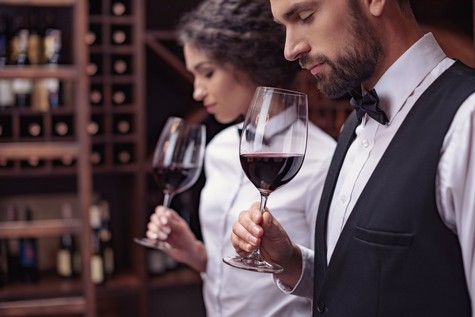
Restaurant professionals tasting with a classic Cabernet/Merlot glass.
In smaller glasses such as the Zinfandel model, the tannin content of a Cabernet Sauvignon can also come across as rough, drying, or bitter. Because the human sensory apparatus receives signals sent to the nose as well as to the tongue in a syncretic fashion (that is, the tongue can "perceive" aromas, while the nose can "taste" sensations such as hot, cold, sweet, or sour), by expanding aromatic perception, the larger surface area of the 21-ounce tulip gives a typical Cabernet Sauvignon a physically smoother, better-balanced feel. In a somewhat similar way, a dark-colored Merlot comes across as a lusher and more velvety in a 21-ounce tulip, which are the qualities you look for in a Merlot.
This glass is also ideal for red wines that have earthy, or non-fruit, nuances. Pronounced earthiness, for instance, is very much a part of Cabernet Sauvignon-dominant reds grown in France's Bordeaux region. It is also a positive attribute of Tempranillo-based red wines grown in Spain. Therefore, if you wish to focus on the red fruit qualities of Tempranillo, a 14-ounce "Zinfandel" glass will do just fine; but if you are indulging in the earthier styles of Tempranillo-based reds imported from Spain, you are more likely to perceive and thus appreciate these complexities in a 21-ounce Cabernet/Merlot glass.
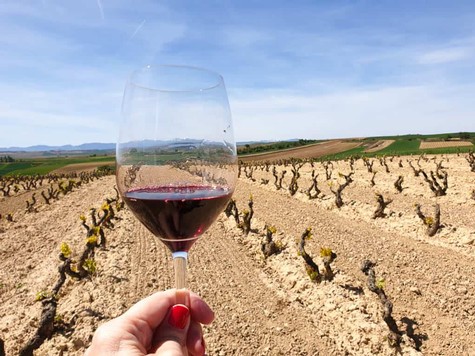
The sensible use of the classic Cabernet/Merlot glass in Spain's Rioja region, primarily planted in Tempranillo.
How does the Cabernet/Merlot glass work for California Zinfandel? As previously mentioned, very well, thank you. Lodi-grown Zinfandels are a little different from, say, Sonoma County Zinfandels in that they are lower in tannin content and can also have earthier qualities—a dimension special to Lodi and more likely to be perceived in 21-ounce glasses than in 14-ounce glasses. The black pepper-like spice qualities of all California Zinfandels are also more perceptible in a larger-sized tulip, notwithstanding research demonstrating that less than 25% of people are readily able to perceive peppery spice in Zinfandel (see our 2016 post, The smell of spice, or rotundone, in autumnal wines).
In a similar way, the 21-ounce Cabernet/Merlot glass can also help to highlight the earthy complexities distinguishing many of the Sangiovese-based red wines of Tuscany, such as Brunello di Montalcino and Vino Nobile di Montepulciano. If you are inclined to spend $50 to $100 for these types of imports, you may as well equip yourself with a wine glass that gives you a higher percentage chance of experiencing all the attributes distinguishing these wines. This is why the size and shape of the classic Cabernet/Merlot glass will always be indispensable
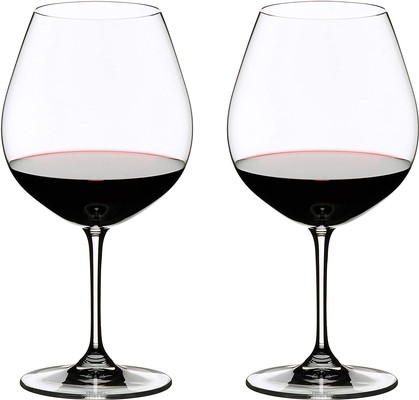
The Riedel Pinot Noir glass; has a 24.75-ounce capacity, and is 8.25 inches tall.
The Pinot Noir "bowl"
One of the joys for many a red wine lover is tasting Pinot Noir in the classic "Burgundy" shaped bowl. Riedel VINUM's model is parred for the course for this traditional wine glass: A wide, spacious 24.75-ounce capacity, standing 8.25 inches tall.
The rounded shape and broad surface area of a classic Pinot Noir shape are ideal because this type of varietal wine is appreciated more for its fruit fragrance and a gentle, soft tannin feel on the palate that suggests silk or velvet texturing. This is different from, say, Cabernet Sauvignon, where you look for aggressive tannin and a more muscular, denser feel.
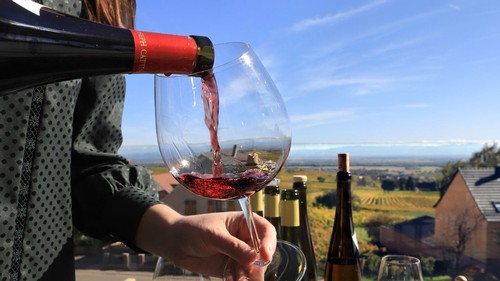
The classic Pinot Noir glass is utilized in the original home of the Pinot Noir grape, Burgundy in France.
Although scientists now say that taste buds sensitive to sensations such as sweetness and bitterness are dispersed throughout the tongue, the significantly wider rim of a Pinot Noir glass does cause a wine to enter the palate closer to the tip of the tongue, which enhances the sensations of "sweet" fruit on the tongue. This perception is not so much psychological as physical: Sampling anything (foods or beverages, particularly when they're hot) closer to the tip of the tongue causes a momentary pause in the tasting mechanism, giving the brain an extra second to process sensations touching all parts of the tongue and triggering retronasal signals (identified as "flavors") sent to the nose.
This is in contrast to the narrower tulip shape of the classic Cabernet/Merlot glass, which drops a wine closer to the middle of the tongue and naturally hastens it to swallow while emphasizing the sensations of tannin and body. The entire idea is that Pinot Noir lovers prefer wines that taste light and delicate, whereas Cabernet Sauvignon lovers prefer a feeling of strength or brawniness—hence, the dramatically different glass shapes which work by altering the perception process.
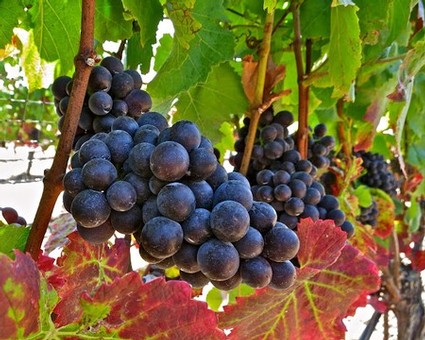
Pinot noir is a grape that produces fragrant, delicate red wines that are best tasted in a large, rounded "Burgundy" glass.
An interesting exercise, if you are able to stock your cabinet with both types of glasses, is to taste a Cabernet Sauvignon in a Burgundy glass and a Pinot Noir in Cabernet glass. If the wines are true to type, a Cabernet Sauvignon tasted in a bowl-shaped glass will taste more diffuse, or less concentrated, than it would in a tulip. A Pinot Noir tasted in Cabernet glass tends to lose a little bit of its fragrance and smooth, delicate feel, especially because its tannin level as well as the sharpness of acidity become accentuated in a Cabernet glass.
By the same token, if you want to "flatten" out the taste of a Cabernet Sauvignon that you think might taste too "big," try it in a Pinot Noir glass. If you want to fill out and taste more of the tannin/acid edge of a Pinot Noir, drink it in a Cabernet glass.
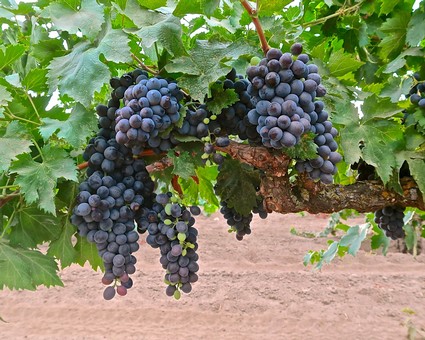
Cinsaut grapes are grown in Lodi's Bechthold Vineyard, which produces soft, fragrant, spicy red wines that taste amazing in rounded Pinot Noir glasses.
The Pinot Noir glass is, in fact, ideal for any red wine that emphasizes softer tannin and a more floral fragrance. Therefore, among other types of French wines, the fruity, easy-drinking red wines of Beaujolais (made from the Gamay noir grape) taste amazing in this glass. In Lodi, the red wines closest in fruit profile and tannin moderation to Pinot Noir and Beaujolais are those made from the Cinsaut, Grenache, and Carignan grapes.
Riedel actually recommends an equally spacious yet much narrower wine glass for Carignan, Grenache, and Cinsaut (i.e., the Syrah/Shiraz/Tempranillo glass addressed below). I would argue, though, since Lodi grows softer, more flowery versions of these varietals than in other parts of the world (be it Southern France, Spain, Paso Robles, or Washington), most Lodi-grown reds made from these grapes can be enhanced by the classic, round Pinot Noir glass.
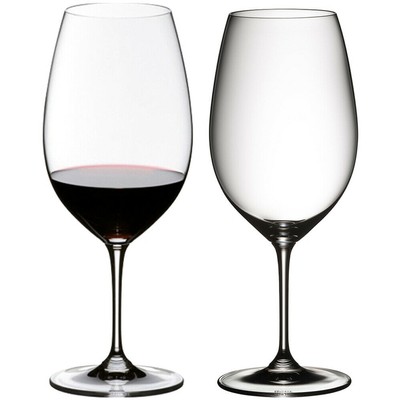
The Riedel Syrah/Shiraz/Tempranillo glass; has a 24.69-ounce capacity, and is 9.29 inches tall.
The Syrah/Shiraz/Tempranillo glass
This glass shape is almost peculiar to Riedel, among all the other popular manufacturers of wine glasses. The wine glass's unusual feature is its long, tall (9.29 inches), vertical tulip shape that is as voluminous in the inner surface capacity as Riedel's bowl-shaped Pinot Noir glass: 24.69 ounces, which is comparable to the Pinot Noir glass's 24.75 ounces. Keep in mind that a bottle of wine contains 25.4 ounces. You can fit almost an entire bottle into one of these glasses.
This glass could also be described as a "Rhône" varietal glass, since besides Syrah, Riedel also recommends it for reds made from Mourvèdre, Grenache, and Carignan grapes. It is also good for Petite Sirah—not technically a Rhône Valley cultivar, but a crossing of Syrah and Peloursin—which makes sense in theory as well as practice because, like Syrah, the voluminous varietal character of Petite Sirah can be enhanced by a glass with a large yet narrow volume of the inner surface.
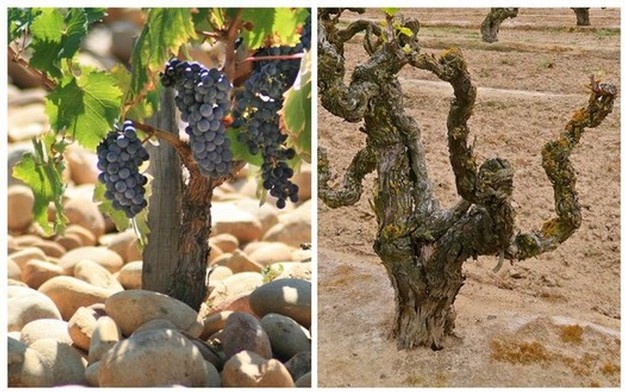
Contrasting terroirs (rocks vs. sand) in France's Rhône Valley (left) and Lodi's Mokelumne River (right), which account for why the more intense, concentrated red wines of the Rhône are more optimal in the large-volume "Syrah" glass than the softer, floral styles of red wine grown in Lodi.
Speaking from first-hand experience, however, I'd offer this caveat: This glass is so big, many of these red wines actually get lost in its cavernous interior. That is to say, rather than coming across as focused or concentrated, aromas can soar out of control, making perception elusive. Even when successful insofar as delivering aromatic intensity to the nose, a dark, vividly perfumed, high-tannin Syrah can come across as rough and jagged when tasted on the palate. In other words, this glass can bring out the best and worse of Rhône style reds. Whenever I experience something to this effect when tasting from this glass, I simply switch to a smaller tulip, such as a classic Cabernet glass. That's the beauty of having multiple glasses on hand.
All the same, the Syrah/Shiraz/Tempranillo glass has a way of enhancing the deep, rich, ripe, and opulent styles of Mediterranean reds; particularly those from France's Rhône Valley or Spain's Ribera del Duero and Toro regions (not so much from Rioja, which are paler colored Tempranillo-based reds better enjoyed in a Cabernet glass). It can be less successful with Lodi-grown iterations of the same varietals, largely because Lodi doesn't really grow an opulent, concentrated style of Syrah or Tempranillo. The Lodi style of these varietals tends to be more floral, a little earthy, and generous without really being compact.
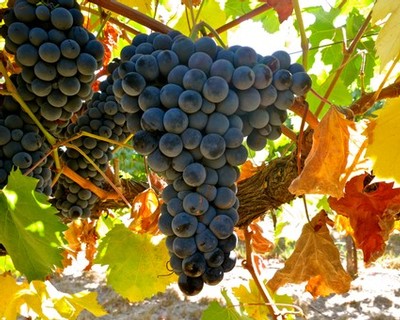
Teroldego, an Italian grape that, is grown in Lodi, produces a black, opaque, high-tannin red wine that benefits from a larger-sized tulip-shaped glass.
Lodi-grown Petite Sirahs, on the other hand, can do very well in this glass. Top brands of Lodi Petite Sirah (such as those of Peltier Winery, Mettler Family Vineyards, Harney Lane, and Michael David's Earthquake) have just enough heft and perfume to get generated positively, to the point of teeming, from out of this glass's voluminous interior. However, lighter-style Lodi Petite Sirahs (such as Ironstone, Oak Ridge's Old Soul, or Michael David's Petite Petit) are not quite big enough. You're better off with smaller-volume tulips with lighter styles of Petite Sirah.
As for Lodi styles of Grenache, Carignan, or Tempranillo: I really can't recommend this glass for these varietals either. You are better off with a standard Cabernet/Merlot glass. Per previous remarks, even an orbicular Pinot Noir glass can at least highlight the soft, flowery, red fruit-scented styles of these varietals when grown in Lodi's Mediterranean climate.
There are, however, other Lodi-grown varietals that do very well in this over-sized tulip: Tannat, Alicante Bouschet, Teroldego, Barbera, Nero d'Avola, Aglianico, Dolcetto, Zweigelt, Dornfelder, Charbono, and Pinotage all have deep enough colors, intense enough aromas, and dense enough palate-feels to find a sense of focus and scale in the Syrah/Shiraz/Tempranillo glass. If you love any kind of dark, concentrated, hefty style of red wine, the "Syrah" glass may very well become your go-to. It certainly has for me!
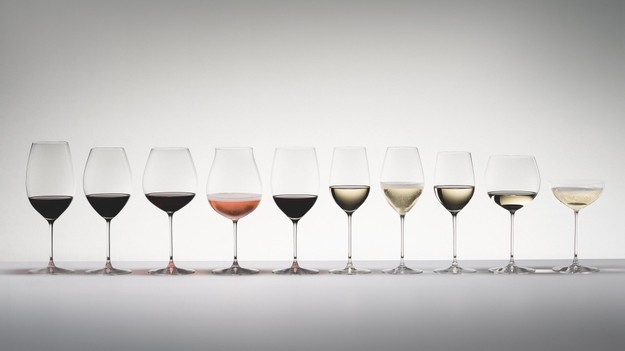
A sampling of the wide range of wine glasses offered by Riedel.